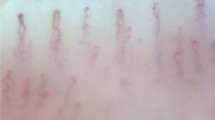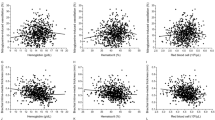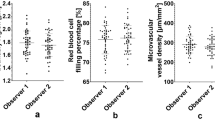Abstract
The pathophysiological significance of hyperviscosity and capillary rarefaction in untreated essential hypertension is unknown. Fifty untreated hypertensive men with capillary rarefaction (intravital capillaroscopy) and 20 age- and sex-matched normotensive controls underwent full haemorheological profiling (blood viscosity at high and low shear, haematocrit, platelet and leukocyte counts, fibrinogen and total protein concentrations, P-selectin levels, erythrocyte and leukocyte filterability rates and erythrocyte deformability and aggregation indexes). Subjects with skin capillary density below the group median had younger age, higher diastolic pressure, higher blood viscosity at low shear, higher P-selectin levels, higher erythrocyte and leukocyte filterability rates, and higher erythrocyte aggregation indexes (all P < 0.01). In contrast, patients with greater skin capillary density had a greater plasma viscosity (P < 0.05). The conclusions were that in untreated hypertensive men, capillary rarefaction and hyperviscosity are associated to an increased diastolic blood pressure and to an adverse haemorheological profile.
This is a preview of subscription content, access via your institution
Access options
Subscribe to this journal
Receive 12 digital issues and online access to articles
$119.00 per year
only $9.92 per issue
Buy this article
- Purchase on Springer Link
- Instant access to full article PDF
Prices may be subject to local taxes which are calculated during checkout
Similar content being viewed by others
References
Lowe GDO . Blood rheology in general medicine and surgery Bailliere's Clin Haematol 1987; 1: 827–861
Letcher RL et al. Direct relationship between blood pressure and blood viscosity in normal and hypertensive subjects Am J Med 1981; 70: 1195–1202
Chien S . Blood rheology in hypertension and cardiovascular disease Cardiovasc Med 1977; 2: 356–360
Harper RN et al. Arteriolar rarefaction in the conjunctiva of human essential hypertensives Microvasc Res 1978; 16: 369–372
Chen IH et al. Microvascular rarefaction in spontaneously hypertensive rat cremaster muscle Am J Physiol 1981; 241: H306–H310
Antonios TFT et al. Structural skin capillary rarefaction in essential hypertension Hypertension 1999; 33: 998–1001
Levy BI et al. Microcirculation in hypertension A new target for treatment? Circulation 2001; 104: 735–740
Bagge U, Branemark PI . White blood cell rheology: an intravital study in man In: Altura BM, Davis E,Harders H (eds) Advanced Microcirculation vol 7: Basel Karger 1977; pp 18–28
Cerletti C et al. P-selectin beta2-integrin cross-talk: a molecular mechanism for polymorphonuclear leukocyte recruitment at the site of vascular damage Thromb Haemost 1999; 82: 787–793
Harkness J . The viscosity of human blood plasma; its measurement in health and disease Biorheology 1971; 8: 171–193
International Committee for Standardization in Haematology (Expert Panel on Blood Rheology). Guidelines on selection of laboratory tests for monitoring the acute phase response J Clin Pathol 1988; 41: 1203–1212
Mikita J, Nash G, Dormandy J . A simple method of preparing white blood cells for filterability testing Clin Hemorheol 1986; 6: 635–639
Lennie SE et al. Filterability of white blood cell subpopulations, separated by an improved method Clin Hemorheol 1987; 7: 811–816
Nash GB et al. Effects of preparative procedures and of cell activation on flow of white cells through micropore filters Br J Haematol 1988; 70: 171–176
Chien S . Principles and techniques for assessing erythrocyte deformability Blood Cells 1978; 3: 71–74
Dintenfass L . Hyperviscosity in Hypertension Pergamon Press: Sidney 1981
Blann AD, Lip GYH . Is soluble P-selectin a new marker of platelet activation? Atherosclerosis 1997; 128: 135–138
Ciuffetti G et al. Peripheral vascular disease. Rheologic variables during controlled Ischemia Circulation 1989; 80: 348–352
Peeters LLH, Buchan PC . Blood viscosity in perinatology Rev Perinatal Med 1989; 6: 53–89
Acknowledgements
We gratefully thank Mrs Geraldine Anne Boyd for her editorial assistance.
Author information
Authors and Affiliations
Corresponding author
Rights and permissions
About this article
Cite this article
Ciuffetti, G., Pasqualini, L., Pirro, M. et al. Blood rheology in men with essential hypertension and capillary rarefaction. J Hum Hypertens 16, 533–537 (2002). https://doi.org/10.1038/sj.jhh.1001454
Received:
Revised:
Accepted:
Published:
Issue Date:
DOI: https://doi.org/10.1038/sj.jhh.1001454
Keywords
This article is cited by
-
Influence of a Decrease in Blood Viscosity on Arterial Pressure in Normotensive and Spontaneously Hypertensive Rats
Bulletin of Experimental Biology and Medicine (2024)
-
Antihypertensive activity of a new c-Jun N-terminal kinase inhibitor in spontaneously hypertensive rats
Hypertension Research (2020)
-
Hypertension and Age-Related Cognitive Impairment: Common Risk Factors and a Role for Precision Aging
Current Hypertension Reports (2020)
-
The GG genotype of the −152 G/A vascular endothelial growth factor (VEGF) polymorphism predisposes to hypertension-related chronic kidney disease
Molecular Biology Reports (2016)
-
Is endothelial progenitor cell dysfunction involved in altered angiogenic processes in patients with hypertension?
Current Hypertension Reports (2004)



